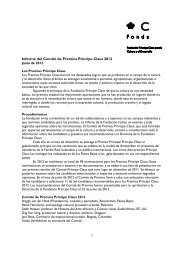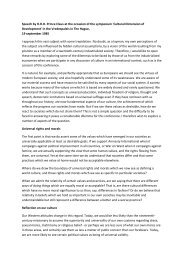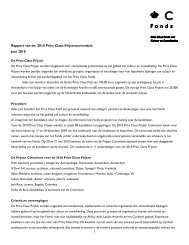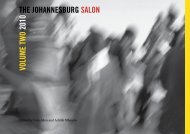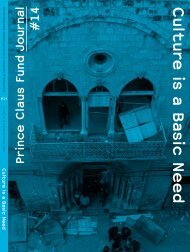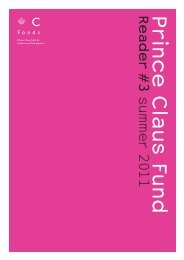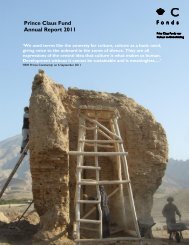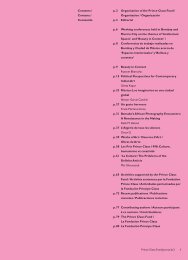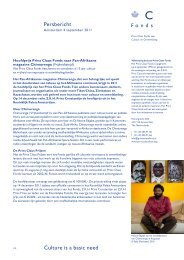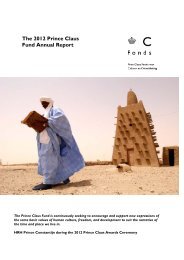30r364 boek.qxd:awards book 11 - Prince Claus Fund
30r364 boek.qxd:awards book 11 - Prince Claus Fund
30r364 boek.qxd:awards book 11 - Prince Claus Fund
Create successful ePaper yourself
Turn your PDF publications into a flip-book with our unique Google optimized e-Paper software.
Passion, Courage and Perseveranceby Patrick VilaireJeanguy Saintus brings to mind a synthesis of the traditional folklore and modern choreographyin Haitian dance. The rise of Jeanguy Saintus resembles the culmination of a struggle by intel -lectuals to promote national culture.From the outset, and in society as a whole, the elite have rejected voodoo and popular religionand culture: the de-Negrification campaigns conducted by the Catholic clergy, the profanationof voodoo temples. Throughout this period, silenced by prohibitions, drums and dances no longerresounded from the peristyles (voodoo temples) in Haiti. Later, around 1946, following theformation of a national folk dance troupe, traditional folklore moved officially from the peristylesinto theatres. This marked the start of a massive movement that pays tribute to the vitality ofpopular culture. The Art Centre was established under the aegis of Dewitt Peters and a few intel -lectuals. Popular painting, known as naive, emerged from the peristyles as well. The celebratedpainter Hector Hyppolite was a voodoo priest. Among singers, Lumane Casimir became popular.Dances performed on stage at theatres starred Jean Léon Destiné.During the colonial era, slavery was the cradle of a medley of different ethnic traditions fromAfrica and elsewhere. Rada, Petro and Congo drums brought us this rich folkloric heritagethrough rhythms and rituals. Later, during the 1950s and 60s, a host of folklore troupes poppedup: Lavinia Williams, Viviane Denervil, the Trouillot ballet, Odette Wiener, Viviane Gauthier,to name but a few. Ayikodans, with Jeanguy Saintus, the former choreographer of the Bacoulouballets managed by Odette Wiener, hails from these origins.***At the first Ayikodans performance at the theatre of the Institut Français I discovered whata talented dancer and choreographer Jeanguy Saintus is. Inspired by folklore, Jeanguy Saintusdirected the performance in a manner that distinguished his troupe from anything done untilnow in Haiti.At my exposé ‘Reflection on Death’ at the Cartier Foundation, in 1997, I recommended theAyikodans company for the Nomad evening. This event, originally conceived by the commissionersof the exposé, was intended to highlight for each country the cultural setting in which theexpressive artists operated. Jeanguy, notwithstanding his diminished troupe, put togethera choreography that impressed audiences in Paris.Jeanguy Saintus featured Haitian dance from a new perspective. By deriving inspiration fromand delving into his culture, he revived it.In his studies on possession frenzy, he preserved the essence of the gestures. He usedmanual and physical dialogue and movements to innovate screenplays and choreography.In its simplicity, his writing resembles the expression of Chinese theatre in hand games. He hasalso added pronounced humanitarian touches to the movements of male and female dancers.In the dance of Gedes, the Banda beats by the star dancer are astoundingly erotic.Considering the challenges that Haiti faces in putting together theatrical productions,Jeanguy Saintus has to improvise everything, from lighting to sets, sometimes operating withonly four hours of electricity a day, in unsafe surroundings. Despite the work he does underthese horrendous conditions and with minimal funding, Jeanguy has enabled young peoplein his country to dance at his school free of charge, thanks to his Dansepienu programme at762008 <strong>Prince</strong> <strong>Claus</strong> Awards



